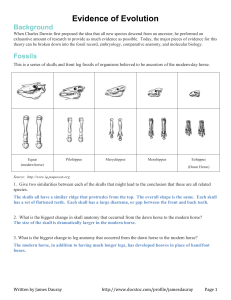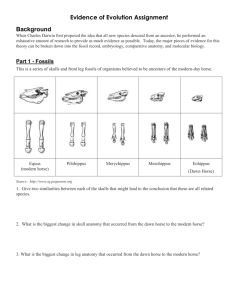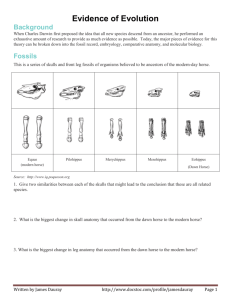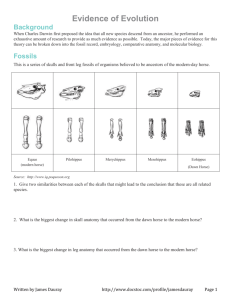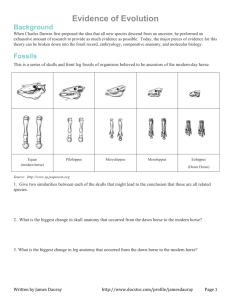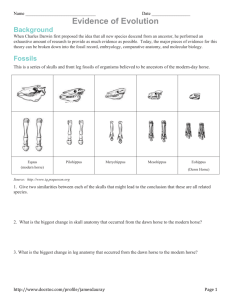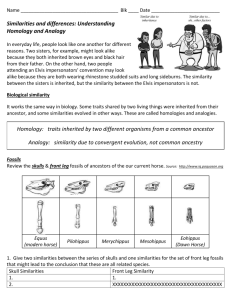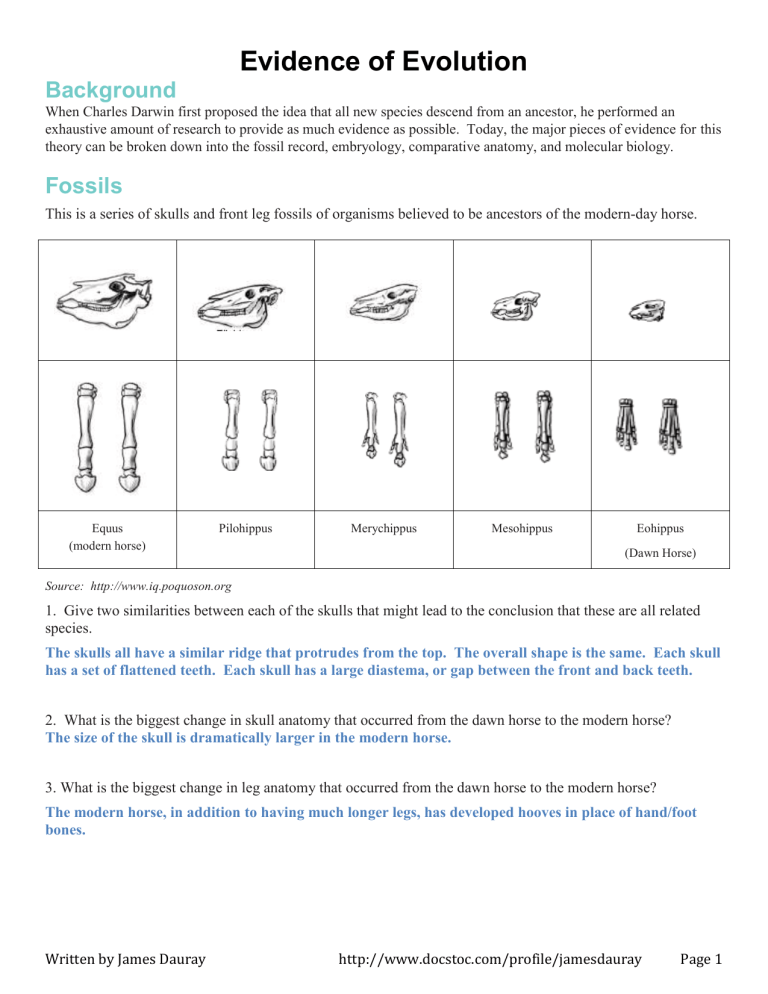
Evidence of Evolution Background When Charles Darwin first proposed the idea that all new species descend from an ancestor, he performed an exhaustive amount of research to provide as much evidence as possible. Today, the major pieces of evidence for this theory can be broken down into the fossil record, embryology, comparative anatomy, and molecular biology. Fossils This is a series of skulls and front leg fossils of organisms believed to be ancestors of the modern-day horse. Equus (modern horse) Pilohippus Merychippus Mesohippus Eohippus (Dawn Horse) Source: http://www.iq.poquoson.org 1. Give two similarities between each of the skulls that might lead to the conclusion that these are all related species. The skulls all have a similar ridge that protrudes from the top. The overall shape is the same. Each skull has a set of flattened teeth. Each skull has a large diastema, or gap between the front and back teeth. 2. What is the biggest change in skull anatomy that occurred from the dawn horse to the modern horse? The size of the skull is dramatically larger in the modern horse. 3. What is the biggest change in leg anatomy that occurred from the dawn horse to the modern horse? The modern horse, in addition to having much longer legs, has developed hooves in place of hand/foot bones. Written by James Dauray http://www.docstoc.com/profile/jamesdauray Page 1 Name: ___________________________ Class: ______________________ Date: ____________________ Embryology Organisms that are closely related may also have physical similarities before they are even born! Take a look at the six different embryos below: Source: http://www.starlarvae.org Hypothesize which embryo is from each of the following organisms: Species Embryo Human Chicken Rabbit Tortoise Salamander Fish These are older, more developed embryos from the same organisms. Hypothesize which embryo is from each of the following organisms: Species Embryo Human Chicken Rabbit Tortoise Salamander Fish Page 2 Name: ___________________________ Class: ______________________ Date: ____________________ These are embryos at their most advanced stage, shortly before birth. Describe how the embryos changed for each of these organisms from their earliest to latest stages. Species Anatomical Changes From Early to Late Stages Human Developed limbs, external ears, a large head, and a nose. Chicken Developed a beak, larger eyes, four limbs including wings, and a short tail. Rabbit Developed four limbs, external ears, a mouth, nose, and a tail. Tortoise Developed a shell, long tail, larger eyes, and a beak. Salamander Developed external gills, four limbs, and a long tail. Fish Developed internal gills and a full set of fins for swimming. 1. Look again at the six embryos in their earliest stages. Describe the patterns you see. What physical similarities exist between each of the embryos? Each of the embryos has the same basic shape, including a tail. They all have external segmentation where the backbone will eventually develop. They also all have gill slits, even the animals that will eventually develop lungs. 2. Does this suggest an evolutionary relationship? Explain how.these embryos can be used as evidence of a common ancestor between each of these six organisms. The similarities between these embryos, especially at their early stages, are striking. While each of these animals has a unique adult body structure, they all seem to have emerged from the same early blueprint. These observations are probably not random coincidence – this suggests a common ancestor between all these vertebrates. Page 3 Name: ___________________________ Class: ______________________ Date: ____________________ Comparative Anatomy Shown below are images of the skeletal structure of the front limbs of 6 animals: human, crocodile, whale, cat, bird, and bat. Each animal has a similar set of bones. Color code each of the bones according to this key: Humerus [ ] Carpals [ ] Ulna [ ] Metacarpals [ ] Radius [ ] Phalanges [ ] Page 4 Name: ___________________________ Class: ______________________ Date: ____________________ For each animal, indicate what type of movement each limb is responsible for. Animal Primary Functions Human Using tools, picking up and holding objects Whale Swimming. Cat Running, jumping, pouncing, climbing, catching prey. Bat Flying, gliding. Bird Flying, gliding. Crocodile Swimming, walking. Compare the skeletal structure of each limb to the human arm. Relate the differences you see in form to the differences in function. Animal Comparison to Human Arm in Form Comparison to Human Arm in Function Whale Whale has a much shorter and thicker humerus, radius, and ulna. Much longer metacarpals. Thumb has been shortened to a stub. The whale fin needs to be longer to help in movement through water. Thumbs are not necessary as the fins are not used for grasping. Cat Cats walk on what would be the toes for humans. Their fifth metacarpal and phalage (thumb) is very reduced. They have a retractable claw. Cats are designed to be ambush predators. They can run much faster, climb, and pounce. Bat The metacarpals and phalanges of bats are much, much longer, narrower, and lighter. There is a webbing of skin between each digit. Bats are capable of flight. Bird The metacarpals and phalanges of birds are very heavily modified, actually coming to a single point at the end of the limb. Birds are also capable of flight, but in a much more advanced way than bats. They generally have more control, are capable of faster speeds, Crocodile The arm bones are shorter and thicker. The middle three digits are much longer than the other two. Crocodiles are built much closer to the ground, and spend a good deal of time swimming. Page 5 Name: ___________________________ Class: ______________________ Date: ____________________ Compare the anatomy of the butterfly and bird wing below. 1. What is the function of each of these structures? Flight. 2. How are they different in form? Give specific differences. The bird wing is constructed of bone, muscle, skin, and feathers. The butterfly wing is a thin membrane of exoskeleton inflated by blood. Compare the overall body structure of the cave fish and the minnow below. 1. What is the biggest, most obvious difference between the body structure of these two fish? The cave fish does not have any eyes. 2. Assume the two fish came from the same original ancestor. Why might the cave fish have evolved without eyesight? As the name suggests, cave fish live in caves that are completely devoid of any sunlight. In this environment, developing eyes would not grant any evolutionary advantage. 3. What kind of sensory adaptation would you hypothesize the cave fish has to allow it to navigate in a cave, including catching and eating food? The cave fish has special sense organs on its body surface that respond to the presence of different chemicals in the water. This would be analogous to our sense of smell. Page 6 Name: ___________________________ Class: ______________________ Date: ____________________ You have now studied three different types of anatomical structures: Homologous structures show individual variations on a common anatomical theme. These are seen in organisms that are closely related. 1. Give an example of a homologous structure from this activity: The limbs of cats, humans, whales, etc. Analogous structures have very different anatomies but similar functions. These are seen in organisms that are not necessarily closely related, but live in similar environments and have similar adaptations. 2. Give an example of an analogous structure from this activity: The bird and butterfly wings. Vestigial structures are anatomical remnants that were important in the organism’s ancestors, but are no longer used in the same way. 3. Give an example of a vestigial structure from this activity: The eyes (or lack of) on the cave fish. 4. Below are some vestigial structures found in humans. For each, hypothesize what its function may have been. Structure Possible function? Wisdom teeth Chewing, grinding raw plant matter. Appendix Digesting cellulose (found in plant matter, like leaves). Muscles for moving the ear Move the external ear so that it captures a specific sound source. Body hair Warmth, protection. Little toe Walking, and running, especially on four legs. Tailbone Primate tails are prehensile, meaning they can grasp things independently. 5. How are vestigial structures an example of evidence of evolution? By definition, these structures are not necessary or advantageous to the organism, so they have been reduced. Evolution by natural selection is the only mechanism that explains why these structures would exist at all – there must have been an ancestor species that did use the structure. Page 7 Name: ___________________________ Class: ______________________ Date: ____________________ Molecular Biology Cytochrome c is a protein found in mitochondria. It is used in the study of evolutionary relationships because most animals have this protein. Cytochrome c is made of 104 amino acids joined together. Below is a list of the amino acids in part of a cytochrome protein molecule for 9 different animals. Any sequences exactly the same for all animals have been skipped. For each non-human animal, take a highlighter and mark any amino acids that are different than the human sequence. When you finish, record how many differences you found in the table on the next page. 42 43 44 46 47 49 50 53 54 55 56 57 Human Q A P Y S T A K N K G I Chicken Q A E F S T D K N K G I Horse Q A P F S T D K N K G I Tuna Q A E F S T D K S K G I Frog Q A A F S T D K N K G I Shark Q A Q F S T D K S K G I Turtle Q A E F S T E K N K G I Monkey Q A P Y S T A K N K G I Rabbit Q A V F S T D K N K G I 58 60 61 62 63 64 65 66 100 101 102 103 104 Human I G E D T L M E K A T N E Chicken T G E D T L M E D A T S K Horse T K E E T L M E K A T N E Tuna V N N E T L R E K A T S - Frog T G E E T L M E K A C S K Shark T Q Q E T L R I K T A A S Turtle T G E E T L M E D A T S K Monkey T G E D T L M E K A T N E Rabbit T G E D T L M E K A T N E Animal Number of Amino Acid Differences Compared to Human Cytochrome C Animal Number of Amino Acid Differences Compared to Human Cytochrome C Horse 5 Shark 14 Chicken 7 Turtle 8 Tuna 11 Monkey 1 Frog 8 Rabbit 4 Page 8 Name: ___________________________ Class: ______________________ Date: ____________________ Molecular Biology – Summary Questions 1. Based on the Cytochrome C data, which organism is most closely related to humans? The monkey, with only one animo acid difference. 2. Do any of the organisms have the same number of differences from human Cytochrome C? In situations like this, how would you decide which is more closely related to humans? The turtle and the frog both have 8 differences from humans. In this case, you would want to examine other forms of evidence -- other proteins, DNA, or compare fossils and homologous structures. Conclusion 1. Charles Darwin published his book On the Origin of Species in 1859. Of the different types of evidence that you have examined, which do you think he relied upon the most, and why? He used homologous structures. Charles Darwin did much of his own research, collecting and comparing specimens from all over the world. He did not have access to the record of fossils that we do today, and the techniques for sequencing DNA and amino acids did not exist. 2. Given the amount of research and evidence available on evolution, why is it classified as a theory? A theory is a broad system of ideas and general principles that explains something. Theories have a lot of evidence and experimentation to support them. Page 9
